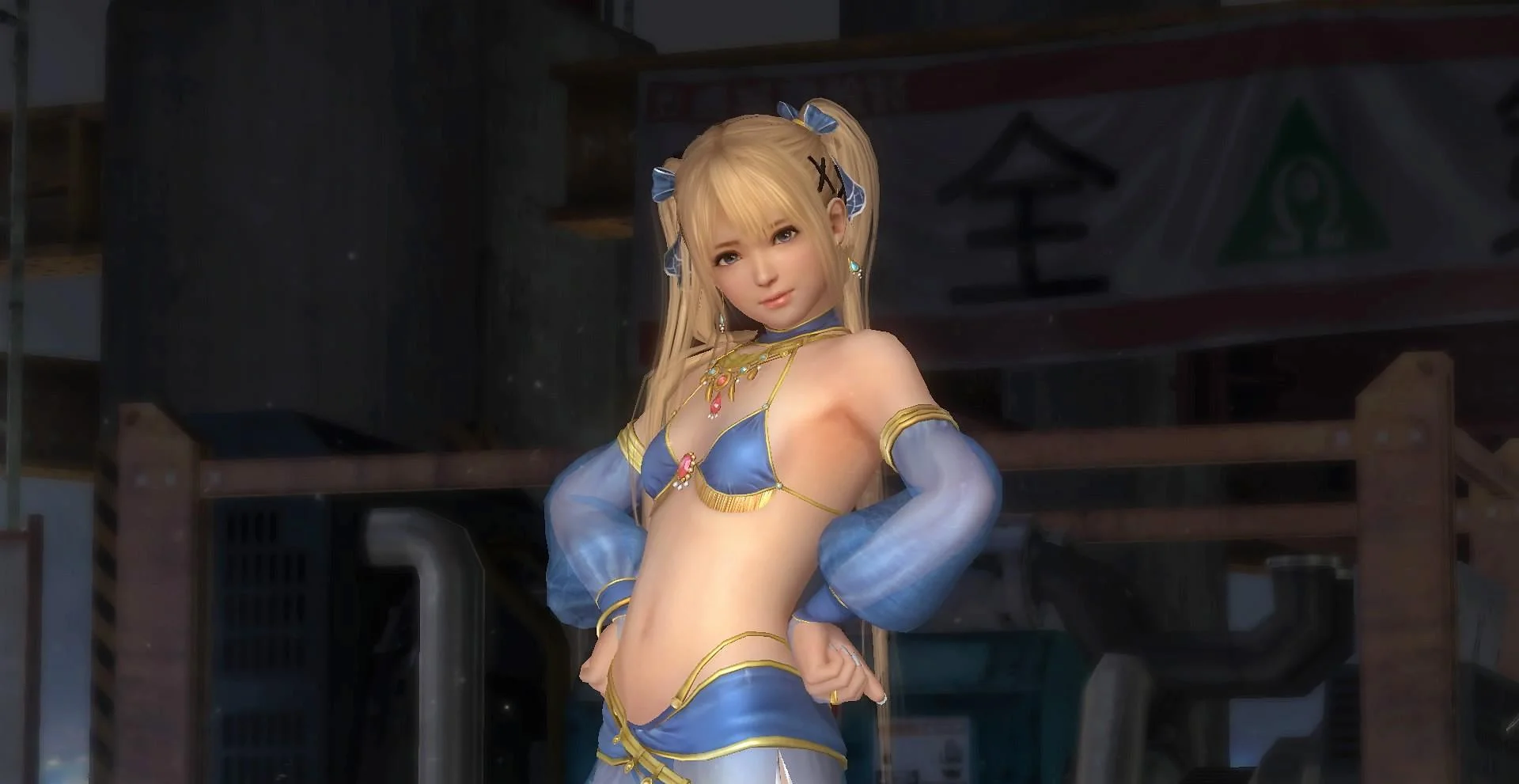For Christmas this year, I was given a copy of a board game based on the classic collection of fantasy short stories; The Arabian Nights: Tales of 1001 Nights. Which is timely, because I am in the process of re-reading that book, having read it last when I was a teenager. Despite being lax in re-reading it, it’s a setting that has been absolutely captivating to me for years now, and one that I feel is badly underrepresented in video games.
Aside from a couple of notable exceptions (the Prince of Persia series, which Ubisoft seems to have given up on now it has Assassin’s Creed, and you can never forget about Shantae), there are few examples of games that make use of a fantasy Middle East as a setting. That’s not really surprising when you consider that something like 30 per cent of Republican voters detest the Middle East so much that they want to bomb fictional cities that have Middle Eastern names, such as Agrabah, therefore suggesting that setting a game in that kind of region will immediately limit the more ignorant demographics from even looking at it, but it’s disappointing nonetheless because it is difficult to think of a setting more exotic, colourful, or vibrant as the sands, glistening palaces, genies and opulent wealth of a fantasy vision of Arabia, Persia or central Asia/ western China and India.
What is more common, however, is one particular piece of clothing that has become emblematic of the aesthetic of the fantasy Middle East. I refer to the female harem costume, of course, which has a habit of popping up wherever there are optional costumes you can stick on characters in Japanese games (and the occasional title from a western developer). Shantae wears a harem costume by default, but beyond her characters as wide ranging as Talim from Soulcalibur, Risette from Persona 4: Dancing All Night, Marie Rose in Dead or Alive 5: Last Round and Maya from Dragon Quest IV and Dragon Quest Heroes all have costumes based on the harem girl fantasy.
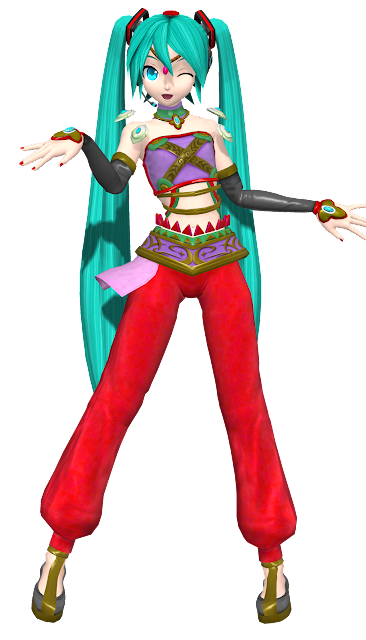 |
| Hatsune Miku from various games (various platforms) |
With the loose fitting (often see-through) pants, bra top, and, occasionally, veil covering the mouth, representing a sensuality and exotic sexuality that is simultaneously more subtle and more typical fan-service costume bonuses like bikinis or school uniforms, harem costumes are my personal preference for my characters. I’ll almost always dress my characters up in such a costume where I can. But, when you think about it, it’s odd that these costumes exist. Not because of the aforementioned cultural differences that mean fantasy Middle East is right out of fashion in the west. There’s no issue there because most of these costumes are found in Japanese-developed games, and the Japanese have far fewer hang-ups over the Middle East and Islam as the Christian-dominated west, led by America, does.
Rather, it’s odd that this costume design would ever exist because never would it have been something seen in the Middle East itself. Islam has been the religion of the region for well over a thousand years now, and Islam certainly wouldn’t get along well with women exposing their midriffs in public, let alone see-though pants or a skirt that offers a crystal clear view of the legs. So, in an effort to explain where the harem costume comes from, let’s take a quick look at the three dominant influences on the modern, western (and Japanese) interpretation of the wardrobe of the fantasy Middle East
1) The Arabian Nights: Tales of 1001 Nights
The obvious first port of call is the one book of stories from the Middle East that is anywhere close to mainstream in western literature; the 1001 Arabian Nights. A misnomer itself, the book, which, translated properly, runs somewhere in the vicinity of 1000 pages, is the one that gave us Aladdin, Ali Baba, Sindbad, and dozens of other well-known stories, and is set in regions as far ranging as Mediterranean Europe through to Africa and India.
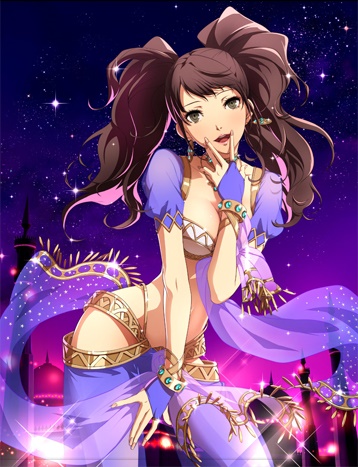 |
| Risette from Persona 4: Dancing All Night (PlayStation Vita) |
It’s through this book that the west really got a taste for a concept as exotic as harem; which really just describes a place in a home/ palace where a man keeps his women (plural; Islam being a polygamous and often seen as misogynistic religion, the only fair way to describe this is of a man acquiring a collection of women). What is interesting to note is that the book never really describes what the women wear, beyond vague references to traditional Islamic garb for them. Which would never mean the harem costume. This in turn means that those art works or films based on the book that you’ve seen featuring women wearing the harem costume are, in fact, examples of artists taking extreme creative license with something the book never directed them to.
We call this process orientalism. As per the Metropolitan Museum of Art (MET) description:
“Orientalism is a fabrication of the West. The perilous voyages to Cathay and Edo, and even the narrower crossing to the mysterious harems and itinerant lifestyles of North Africa and the Middle East, gave Europe a secular heaven-on-earth, a paradise undefiled by Western civilization.”
At the same time, harem costumes do, in fact, fit the theme of the stories in 1001 Arabian Nights. With very, very few exceptions, women in that book are positioned as seducers, temptresses and nymphomaniac succubi that exist to tempt men into doing bad things, and need to be beaten into submission or executed for their deceptions (yes, again, a very misogynistic book – I’m not justifying this by any means).
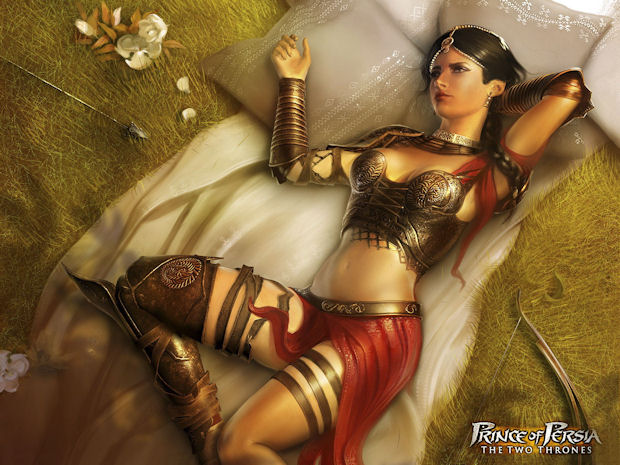 |
| Farah from Prince of Persia series (PlayStation 2, 3) |
Take this passage for example:
“She then took the cup, drank it, and sat down with her sister. They continued to drink, with the [male] porter seated between them, and as they drank, they danced, laughed, and sang, reciting poems and lyrics. The porter began to play with them, kissing, biting, rubbing, feeling, touching and taking liberties. One of them would give him morsels to eat, another would cuff him and slap him, and the third would bring him scented flowers. With them he was enjoying the pleasantest of time, as though he was seated among the houris of Paradise.”
As you can see from that passage, not uncommon for the book, the exotic sensuality and sense of fantasy in the way 1001 Arabian Nights treats the topic of sex is strong, leading itself quite well to the aesthetic of stylised costumes that emphasise a woman’s sexuality.
And that’s not to say a game/ book/ film/ whatever that uses such aesthetics necessarily needs to be misogynistic as the original text. Pair those costumes with an empowered female hero (as plenty of the modern reworkings of the 1001 Arabian Nights tales have done, such as in my new board game), and you’ve got a fascinating, subversive example of a female hero that looks like she should be from an Islamic country, in using the confines of a hugely misogynistic aesthetic to present a strong feminist message.
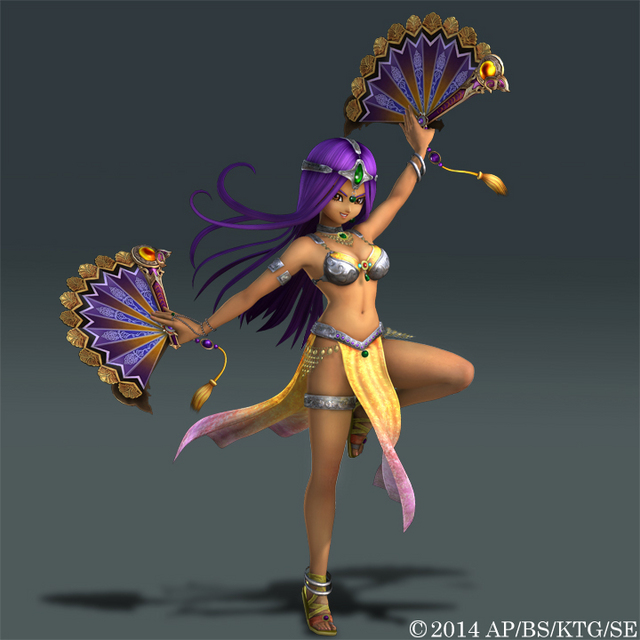 |
| Maya from Dragon Quest Heroes (PlayStation 4) |
2) Paul Poiret
In actual fact, the design of the modern harem costume that we know so well did not come from the Middle East at all, fantasy or otherwise. No, it likely came from a European; one of France’s absolute masters in fashion design art by the name of Paul Poiret.
Related: An example of Paul Poiret’s designs.
Poiret took the concept of loose fitting pants from examples of clothing from the Ottoman Empire (now Turkey) and, in the 1910’s, unleashed “harem pants” on the world. Though credited with establishing the modern context for fashion, his work with designs such as the harem pants has not been without controversy in the years since: the aforementioned MET Museum dismissed designs such as this as:
“Like his artistic confrere Leon Bakst, Poiret’s exoticized tendencies were expressed through his use of vivid colour coordinations and enigmatic silhouettes such as his iconic “lampshade” tunic and his “harem” trousers, or pantaloons. However, these orientalist fantasies have served to detract from Poiret’s more enduring innovations, namely his technical and marketing achievements.”
However, criticisms aside, those pants were incredibly effective in tapping into the exotic vision that the west has in its mind when thinking about the Middle East, and we started to see Poiret’s harem pants, or close variations thereof, in western entertainment, from cabaret to Hollywood’s early films (America wasn’t always as reticent in suggesting that the Middle East could be a source of exciting adventure and heroism as it is now).
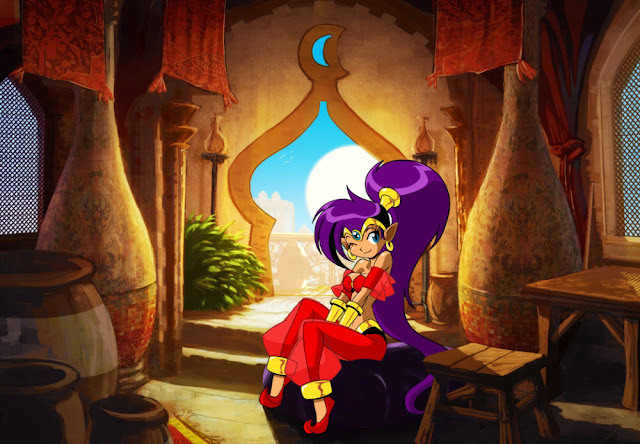 |
| Shantae from Shantae series (various platforms) |
The design has since endured. As with the bikini, we’ve seen harem pants become significantly more daring and revealing over those heady early days when just the idea of them was near-blasphemous. It’s common enough these days – especially in Halloween costumes, bedroom play, and film/games costume design – for the outer pants material to be opaque or virtually see through, with a matching-coloured underpants or g-string being about the only thing protecting the girl’s modesty, but the genesis of these designs – at least from a western or non-Middle Eastern Asian point of view – can quite strongly be drawn back to a artistic revolution led by the “Picasso of fashion”.
3) Belly dancing
The development of the harem costume also closely mirrors the development of the modern belly dancing costume, to the point now where they are virtually indistinguishable from one another.
It wasn’t always the case. Though information on early belly dancing costumes is hard to come by, it is very likely that, even if they shared some similarities with the modern designs, they would be far more conservative, else the girls doing the dancing would be considered haram (forbidden) in the cultures where the dancing style developed out of. At the least, it is likely women would wear a kind of shirt when participating in traditional belly dancing.
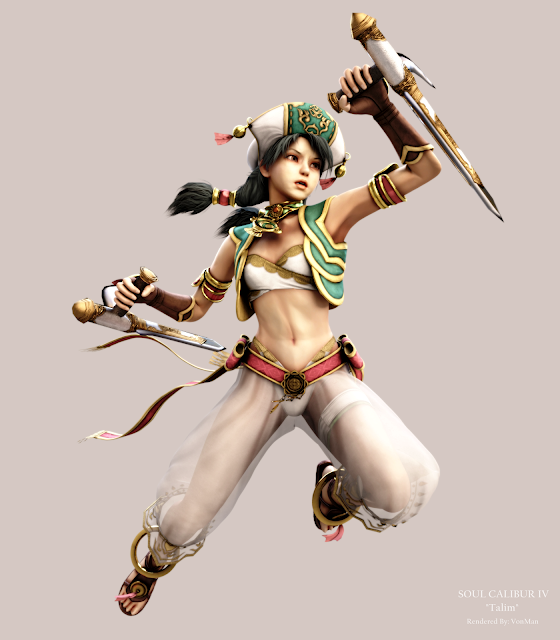 |
| Talim from Soulcalibur (various platforms) |
It was in the 1920’s, when the likes of Badia Masabni were performing, that the genesis of the modern belly dancing costume emerged. It seems likely that performers such as Masabni adopted the midriff-bearing bra top and leg revealing skirt or pants to appeal to a western market that was, at the time, enjoying these things through film. As that proved to be popular and, whatever accusations of immodesty there might be about it, it is certainly a costume that, practically, actually helps to emphasise the skill of a belly dancer, the design stuck, and has itself become the default costume of a belly dancer.
So, there you have it. The “Arabian harem” costumes that you keep seeing pop up in your JRPGs, fighting games, and rhythm games have very little to do with the actual Middle East; be that fantasy or reality. Instead, they are garments that have been, over longer than a century, developed by westerners deliberately misreading Middle Eastern fantasy to enhance the sensuality and sexuality of the exotic women that come with the genre, and then enhanced and developed when a form of dancing came to realise that these costumes turned the dance into something visually appealing to a large audience, and helped to emphasise the skill of the dancers themselves.
Not that there’s anything wrong with any of that. Ultimately it doesn’t matter where the actual design of the costume comes from. It’s meant to represent femininity, sexuality and an exotic setting, and as we’ve seen in all those games that feature harem costumes (not to mention films as far ranging as Disney’s Aladdin to Star Wars), it does in fact do that. It’s simply a particularly fascinating garment, and the history behind it is fascinating in its own right.
– Matt S.
Editor-in-Chief

